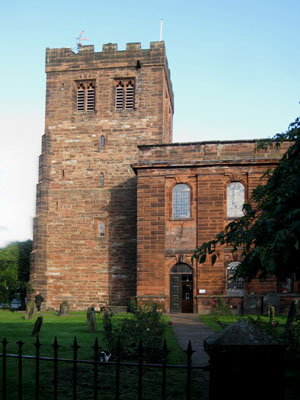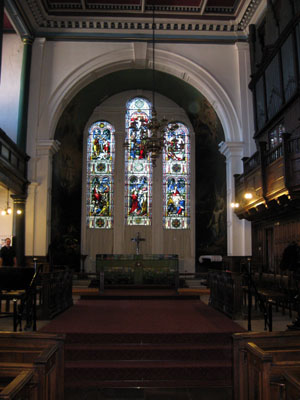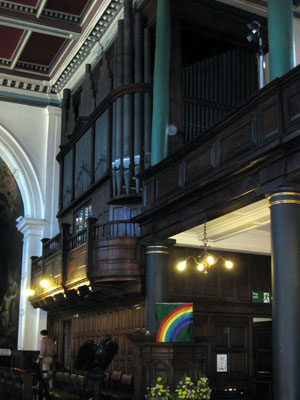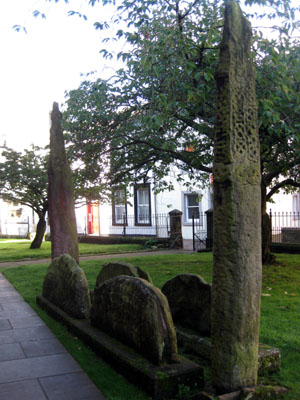| |
 |
 |
 |
| Comment on this report, or find other reports. |
 |
| Our Mystery Worshippers are volunteers who warm church pews for us around the world. If you'd like to become a Mystery Worshipper, start here. |
 |
| Find out how to reproduce this report in your church magazine or website. |
|
|
| 2775: St Andrew's, Penrith, Cumbria, England |
 |
 |
 |
Mystery Worshipper: Kingsfold.
The church: St Andrew's, Penrith, Cumbria, England.
Denomination: Church of England, Diocese of Carlisle.
The building: It’s an interesting set of contrasts. As you approach from the town, you see the church tower above the buildings thereabouts, and this is very square and traditional in style, dating from the 13th century. It’s only when you get to the church and look at it from the side that you realise that, apart from the tower, the rest of the church is very much a Georgian box. This dates from the 1720s, and according to the information board outside, whilst no one knows who designed it, some say it may have been Nicholas Hawksmoor, who was a pupil of Sir Christopher Wren. There is a curious grave in the churchyard, marked by semi-circular stones and upright pillars, which local legend says marks the grave of Owen, 10th century king of Cumbria, or the mythical giant Sir Owen Caesarius, who lived in a cave by the River Eamont. Moving into the church, one finds a sizeable narthex at the west end, stretching the width of the church. The main body is as Georgian as the exterior suggests. The pews and extensive interior woodwork are dark oak, as is the balcony running round three sides. The east window is surrounded by a mural, painted by a local artist, Jacob Thompson, in 1845. Unusually, the pulpit and lectern are both on the south side of the sanctuary: I imagine the lectern was moved from the north side to make space for the grand piano that is in the analogous space. It’s a big space, which all that dark oak didn’t overwhelm.
The church: There is the usual range of groups and activities running: choir, mother’s union, Tuesday club, etc. They also have a parish centre, and I’m guessing that’s probably where the children and youth groups meet.
The neighbourhood: Penrith was once the capital of Cumbria, with a long history and many historic buildings, including castle ruins. These days it is a bustling shopping town, with a mixture of local independent businesses and the usual chain stores. There are also lots of little yards running off the main streets and linking them, which makes the town centre an intriguing place in which to wander. Penrith is also about three miles outside the boundaries of the Lake District National Park, and serves as a hub for the north east Lakes.
The cast: The celebrant was the Revd Colin Sands, assistant priest.
The date & time: 12 October 2014, 10.00am.
What was the name of the service?
Parish Communion.
How full was the building?
There were probably around 70 people there. They were well distributed on either side of the nave, which made the building look pleasantly full, though the capacity of the building is substantially greater (and that doesn’t include the balcony). The majority were middle aged, though the artwork displayed around the church indicated that there is a Sunday school or other children's work going on.

Did anyone welcome you personally?
Yes, indeed. One of the churchwardens greeted me on my way, saying "Good morning," and we exchanged a few words about the weather. As I slid into my pew, the gentleman behind me also said good morning, and when we came to the peace, another gentleman crossed over the nave to greet me and to say, “Welcome to St Andrew’s.”
Was your pew comfortable?
They were wooden bench pews: neither especially comfortable nor uncomfortable. The ledge on the back of the pews was, however, pretty narrow, and whilst it would take the hymn book (just) you couldn’t put the service book on it.
How would you describe the pre-service
atmosphere?
It was quite busy, with a lot of folk meeting and greeting. However, despite the moderate hubbub going on, it wasn’t intrusive.
What were the exact opening words of the
service?
“Good morning, everybody. It’s good to be with you again.”
What books did the congregation use during the
service?
Common Worship Order 1, which was a locally produced version for St Andrews. The hymn book was Hymns Ancient & Modern: Hymns and Songs for Refreshing Worship. I was also given a pew/notice sheet that contained the readings.
What musical instruments were played?
The organ, an opus of TH Harrison of Rochdale dating from 1870, rebuilt and refurbished by various firms over the years.

Did anything distract you?
I’d clearly chosen to sit in someone’s pew, as I had to move up to allow a group of four ladies to sit down together. Now, I’m right-handed, and they sat on my right hand side, which made discreet note-taking almost impossible, and I felt very, very visible as I scribbled away. It was also rather unnerving to notice that the gentleman in the pew behind me was also taking notes in a little red notebook throughout the service, and I did briefly wonder if there were in fact two Mystery Worshippers present. On the other hand, if he was a local and usually took notes, there was a fair chance my less than subtle scribblings were just seen as normal.
Was the worship stiff-upper-lip, happy clappy, or
what?
It was probably best described as middle-of-the road Anglican. It was a fairly standard Common Worship Order 1 liturgy with a small robed choir. No fuss, no frills.
Exactly how long was the sermon?
21 minutes.
On a scale of 1-10, how good was the preacher?
6 – Difficult one this. On a personal level, I don’t really like the “audience participation” approach in a sermon, and I’d much rather have something based on the lectionary for the day. That said, most of the rest of the congregation responded fairly enthusiastically to discussing material amongst themselves, and seemed to be engaged with what they were learning about the gospel of Matthew, so from that perspective, I’ll score at 6.
In a nutshell, what was the sermon
about?
Well, it certainly wasn’t about any of the readings! We were first invited to take some time to share with our neighbour all we knew about St Matthew. My neighbours didn’t want to play, which left us sitting there looking like a bunch of stuffed shirts. We were then given a potted history of St Matthew, which all took around six minutes. Next we moved onto St Matthew’s gospel, its sources and what it shared in common with the other synoptic gospels, before being asked to turn again to our neighbours and talk about the bits of the gospel that are unique to Matthew. And to make sure we’d picked up on everything, we were given a list of all the material that appears only in Matthew (also available in handout form after the service). Finally, we got to the nub of the sermon: Matthew is focused on responding to Christ’s command to go out and tell others. Spread the good news. And the challenge is personal, to each of us: with whom are you going to share the good news of God?
Which part of the service was like being in
heaven?
During the last hymn, a toddler ran up the central aisle, pursued shortly afterwards by her mother. She headed up to the altar, then dived off into the side chapel and back toward the rear of the church, followed by Mum. She circled round again, as her mother paused to try and head her off. I was both amused and enchanted by the little girl racing round the church so happily, and her happiness was infectious.
And which part was like being in... er... the other place?
The congregation were going up to receive communion, and at this point there was no accompanying music. I was enjoying the quiet, and thinking how refreshing it was, when it was shattered by a very loud and very clear “The body of Christ.” It then returned to a gentle murmur of those words, before it happened again. This repeated a number of times, and I’m sorry to say that I was increasingly irritated until I realised that in fact the volume of these words was being pitched to whomsoever was receiving at the time. And then I felt ashamed of my irritation – forgive me, Father.
What happened when you hung around after the service looking lost?
Not a whole heap for a while. I stayed in place and listened to the organ voluntary, hung around and took some photos, then headed for the coffee. And then I stood quietly drinking my coffee and minding my own business. Eventually, the gentleman who had welcomed me at the peace came over and chatted for a while. I had wondered if he would, given that he’d marked me as a newcomer at the peace, but up until that point in time, he’d been in the side chapel where he (and another) made themselves available to pray with any who wanted that.
How would you describe the after-service
coffee?
Warm and wet, and shortbread and wee mince pies were also available.
How would you feel about making this church your regular (where 10 = ecstatic, 0 = terminal)?
5 – I can’t honestly say I had any strong feelings one way or the other, but I would be happy to visit again.

Did the service make you feel glad to be a
Christian?
Yes, I think so. It had been a busy and stressful time, and it was good to be able to worship God without too many other cares and concerns.
What one thing will you remember about all this in seven days' time?
The little girl smiling and chasing so happily around the church. |
|
|
 |
 |
 |
| We rely on voluntary donations to stay online. If you're a regular visitor to Ship of Fools, please consider supporting us. |
 |
 |
 |
| The Mystery Pilgrim |
 |
| One of our most seasoned reporters makes the Camino pilgrimage to Santiago de Compostela in Spain. Read here. |
 |
 |
 |
| London churches |
 |
| Read reports from 70 London churches, visited by a small army of Mystery Worshippers on one single Sunday. Read here. |
| |
|
|
|
|


